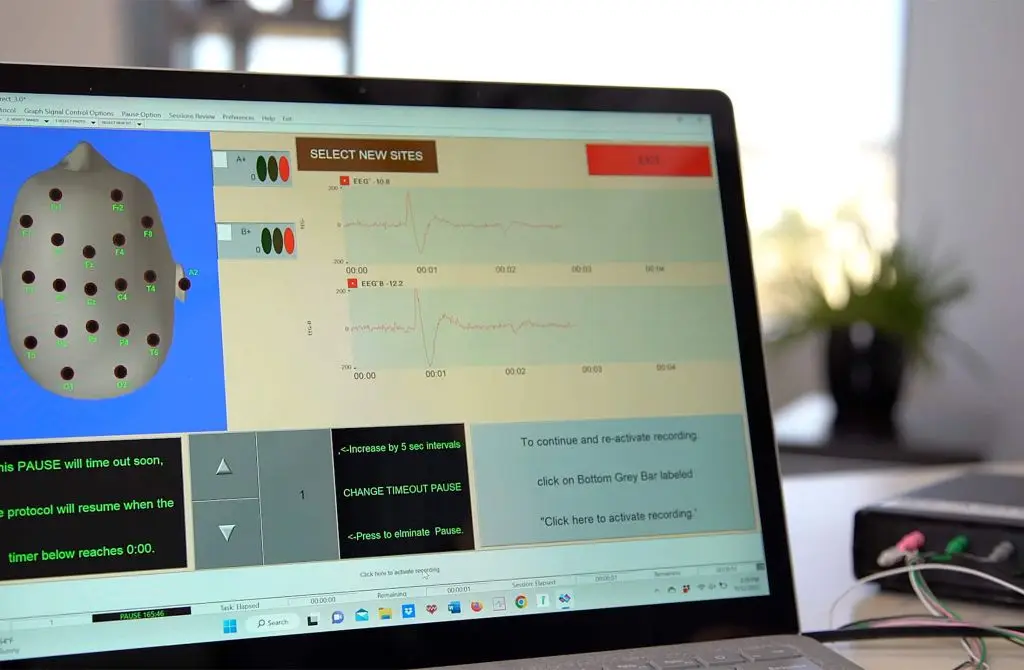Neurofeedback Practices
Neurofeedback capitalizes on the brain’s potential for growth and change. It stimulates the brain’s neuroplasticity and has shown promise in addressing a myriad of challenges, from stress and anxiety to cognitive function. Older neurofeedback technology has been used in clinics for decades. CLARITY Direct Neurofeedback™ (CLARITY), the newest form of technology, does not rely on operant conditioning. Rather, it offsets dysfunctional neural pathways by sending a customized, imperceptible microstimulation to the brain, allowing the brain to reboot itself and restore optimal functioning. Once the brain can reorganize and stabilize, clients often feel less reactive and more resilient. Healing and improved cognitive performance can follow.
CLARITY is a leading system physicians, psychiatrists, therapists, chiropractors, and recovery clinics have chosen to incorporate in their practices. Adding CLARITY neurofeedback into a therapeutic or medical practice can expand clientele and revenue, while accelerating client healing and enduring, positive outcomes. In this blog, we’ll explore the importance of establishing clear and attainable goals for a thriving neurofeedback practice. You’re advised to open a notes app or grab a pen and pencil as this blog includes prompts to define your neurofeedback practice goals.
Defining Success in Your Neurofeedback Practice
Success in neurofeedback isn’t one-size-fits-all. It’s as diverse as the individuals seeking its benefits. For some, it may mean enhancing client progress by reducing specific symptoms. For others, it could be about increasing caseload or revenue. Take a moment to reflect on what success means to you in the context of your neurofeedback practice – is it seeing clients thrive, achieving personal goals, or a combination of both? Write down something you’d like to be doing in your neurofeedback practice in 1 month, 6 months, 1 year and 5 years. Write down anything that comes to mind without judgment.
Goal Setting Framework for Neurofeedback Practice
We can actualize goals when they are specific, measurable, achievable, relevant, and time-bound, otherwise known as SMART. The SMART goal framework can be used for a neurofeedback practice and for the clients with whom you work. Introduce the SMART framework (Specific, Measurable, Achievable, Relevant, and Time-bound) as a tool for setting effective goals. Let’s breakdown each part:
- Specific: Don’t dance around vagueness. Clearly define what you want to achieve. For instance, rather than a vague “get good client outcomes,” try “reduce all client anxiety symptoms by 4 points on a ten point scale.”
- Measurable: Make it tangible. Set metrics to track progress – whether it’s symptom reduction percentages, cognitive test scores, or the number of neurofeedback sessions completed.
- Achievable: Set goals that are challenging yet attainable, considering needs and limitations.
- Relevant: Ensure goals align with the clients’ overall well-being and your personal objectives and professional mission.
- Time-bound: Assign deadlines for achieving each goal to provide a sense of urgency which can inspire focus and motivation. Deadlines also give a clear endpoint for assessing when the goal is met.
Let’s see an example for a neurofeedback practice wanting to increase its caseload:
- Specific: Increase the caseload of my neurofeedback practice, specifically targeting clients with symptoms of anxiety and ADHD.
- Measurable: Increase the caseload of my neurofeedback practice by 20% more than my current roster as of June 1, 2024, specifically targeting clients with symptoms of anxiety and ADHD.
- Achievable: I can increase the caseload of my neurofeedback practice by 20% more than my current roster as of June 1, 2024, specifically targeting clients with symptoms of anxiety and ADHD, by implementing marketing strategies, including google and facebook ads, cross-referrals with local healthcare providers, and a referral/loyalty program to encourage existing clients to recommend practice to others.
- Relevant: Increasing my caseload by 20% aligns with my neurofeedback practice’s mission of providing accessible and effective direct neurofeedback services to a wide range of clients. By expanding my caseload, my neurofeedback practice can reach more individuals in need and contribute to the overall well-being of my community.
- Time-bound: In six months, I can increase the caseload of my neurofeedback practice by 20%, specifically targeting clients with symptoms of anxiety and ADHD.
Here’s another example, this time of a setting goal with a neurofeedback client:
- Specific: The client will enhance their ability to manage anxiety by achieving a reduction in their self-reported anxiety levels over the next eight weeks, through consistent participation in direct neurofeedback sessions.
- Measurable: The client’s progress will be measured using pre and post-session self-assessment scales, tracking anxiety levels before and after each CLARITY session on a scale of 1 to 10 (10 being panic attack that requires hospitalization). The goal is to achieve a minimum 30% reduction in self-reported anxiety scores by the end of the eight-week period.
- Achievable: Given the client’s commitment to attending two CLARITY neurofeedback sessions per week, a 30% reduction in anxiety levels is deemed
- Relevant: Reducing anxiety is directly relevant to the client’s overall well-being and the initial concerns that led them to seek direct neurofeedback therapy. Reduced anxiety without prescription medications is expected to positively impact the client’s daily life, emotional well-being, and overall mental health.
- Time-bound: The client will work towards this goal over the next eight weeks. At the end of the eight weeks, a comprehensive evaluation will determine the success of the CLARITY in achieving the anxiety reduction target.
Collaborative Goal Setting with Clients
Goals aren’t a one-way street. Involve your clients in the process. Involving clients in setting their own goals for neurofeedback sessions is crucial as it fosters a sense of ownership and empowerment, ultimately enhancing motivation and engagement. This client-centered approach ensures that the neurofeedback sessions are meaningful and relevant, contributing to a more effective direct neurofeedback experience.
The goal-setting journey is a partnership – navigate it together. Listen to your clients expectations, share your insights and mitigate expectations to find common ground. Address potential challenges like unrealistic expectations with empathy and transparency. Repeat their words and incorporate them into a written goal that you can email or text. Once you have created the goal together, discover and write down specifically what the client will gain by achieving this goal. The more specific, the better. This discovery can be used when setbacks or challenges arise like lack of motivation.
Maintaining Motivation and Tracking Progress
Progress isn’t a one-time event; it’s a continuous journey that often follows the orbit of an upward spiral. A client may revisit old habits or symptoms, only to show how they bounce back quicker with improved resiliency. Setbacks are not “wrong,” they are part of the body’s attempt to reorganize and process trauma. Sometimes, clients become so focused on one setback they forget the positive gains that have come previously. For this reason it is crucial to recording progress in written notes.
Each session you will track client symptoms on a 1-10 scale, but you can also encourage the client to keep a log or journal between sessions. This can be a handwritten journal or something on their phone. You can also offer your clients CNSVS, an online test that can be taken repeatedly to monitor neurocognitive performance. This provides hard data beyond self-report. Other strategies to maintain client motivation include celebrating successes, acknowledging setbacks while always refocusing to a reduction in intensity, frequency or duration, i.e., a gain in resiliency. And of course, you can always adjust the goal as needed. The key is keeping the momentum alive, both for your client and within your neurofeedback practice.
In Conclusion
Progress is most likely made when goals are written down. For your neurofeedback practice, remember to set specific, measurable, achievable, relevant, and time-bound goals. Challenge yourself enough that it may seem slightly uncomfortable; a sense of urgency can increase focus. Be empathetic as you navigate through external situations which you may not have control of. Celebrate progress made in your neurofeedback practice by reinvesting in practice or honoring your work.
For the clients of your neurofeedback practice, show them success is a collaborative effort and you are here to remind them of their motivation to heal and grow. Keep detailed notes of their measured progress. Encourage them to reflect between sessions with a journal or log. Once you witness the transformations that come, not only from direct neurofeedback, but also from setting clear goals, the possibilities erupt.
Your Neurofeedback Practice Community
Your experiences matter. Share your direct neurofeedback practice goals, successes, and challenges. Build a community where insights can be exchanged to motivate and inspire yourself to continue growing. If you feel the need for such a community, consider becoming a CLARITY Certified Provider. Once certified, CDN providers receive a growth toolkit which is updated quarterly and ongoing continuing education workshops that cover a variety of provider-suggested topics from case studies to business help.
If you have questions about becoming a CLARITY provider, schedule a strategy session with the CLARITY Direct Neurofeedback™ founder. Thousands of CLARITY providers have achieved their goals of expanding their practice while increasing revenue, doing more in less time. If you’d like to understand how CLARITY can fit into your medical, therapeutic or neurofeedback practice, schedule your strategy session today.




